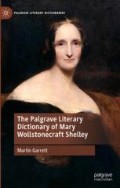Abstract
The first visual images of Frankenstein are a poster of ∗Cooke as a tall, athletic creature in ∗Presumption, and the frontispiece of Milner’s The Man and the Monster (1826) showing O. ∗Smith’s creature with long, curly black hair. Neither these pictures nor Theodor von Holst’s frontispiece for the 1831 edition of the novel suggest the brutish figure of later tradition. In Holst, says The London Literary Gazette for 19 November 1831, he is ‘more gigantic than frightful, and the face is deficient in that supernatural hideousness on which the author so especially dwells’ (p. 740). While the frontispiece contains skulls, a skeleton and a Gothic arch, Moreno and Moreno (2018) point out, its emphasis, like that of the novel, is on the ‘fact of the abandonment of the creature and its social costs, not the creation itself and its possible ethical consequences’. Frankenstein’s irresponsibility is established because, as Shelley (2012) notes, he both runs from his creature here, and parts from Elizabeth in Holst’s title-page illustration (p. 329).
Access this chapter
Tax calculation will be finalised at checkout
Purchases are for personal use only
Bibliography
Bandiera, Laura and Saglia, Diego (ed.) (2005), British Romanticism and Italian Literature: Translating, Reviewing, Rewriting (Amsterdam and New York: Rodopi).
Bukatman, Scott (2018), ‘Frankenstein and the Peculiar Power of the Comics’, in Davison and Mulvey-Roberts (2018), pp. 185–207.
Burwick, Frederick, and Douglass, Paul (eds) (2011), Dante and Italy in British Romanticism (Basingstoke and New York: Palgrave Macmillan).
Crook, Nora (2001), ‘“Meek and Bold”: Mary Shelley’s Support for the Risorgimento’, in Crisafulli and Silvani (2001), pp. 73–88.
Guerra, Lia (2005), ‘Mary Shelley’s Contributions to Lardner’s Cabinet Cyclopaedia: Lives of the Most Eminent Literary and Scientific Men of Italy’, in Bandiera and Saglia (2005), pp. 221–35.
Marino, Elisabetta (2011), Mary Shelley e l’Italia: il viaggio, il Risorgimento, la questione femminile (Firenze: Le lettere).
Moreno, Beatriz González and Moreno, Fernando González (2018), ‘Beyond the Filthy Form: Illustrating Mary Shelley’s Frankenstein’, in Davison and Mulvey-Roberts (2018), pp. 227–44.
Murray, Christopher (2016), ‘Frankenstein in Comics and Graphic Novels’, in Smith (2016a), pp. 219–40.
Neff, D.S. (1997). ‘Hostages to Empire: the Anglo-Indian Problem in Frankenstein, The Curse of Kehama, and The Missionary’, European Romantic Review 8, pp. 386–408.
Sanborn, F.B. (1907), The Romance of Mary W. Shelley, John Howard Payne and Washington Irving (Boston: Boston Bibliophile Society).
Schoina, Maria (2009), Romantic ‘Anglo-Italians’: Configurations of Identity in Byron, the Shelleys, and the Pisan Circle (Farnham: Ashgate).
Scott, Grant F. (2012), ‘Victor’s Secret: Queer Gothic in Lynd Ward’s Illustrations to Frankenstein (1934)’, Word & Image 28, pp. 206–32.
Shelley, Mary Wollstonecraft (1994a), Frankenstein or the Modern Prometheus: the 1818 Text, ed. Marilyn Butler (Oxford: Oxford University Press).
Shelley, Mary Wollstonecraft (1994b), The Last Man, ed. Morton D. Paley (Oxford: Oxford University Press).
Shelley, Mary Wollstonecraft (1997a), Lodore, ed. Lisa Vargo (Peterborough, Ontario: Broadview Press).
Shelley, Mary Wollstonecraft (2000), Valperga, or, The Life and Adventures of Castruccio, Prince of Lucca, ed. Michael Rossington (Oxford: Oxford University Press).
Shelley, Mary Wollstonecraft (2009), Frankenstein, ed. Stuart Curran, Romantic Circles (https://www.rc.umd.edu/editions/frankenstein).
Shelley, Mary Wollstonecraft (2012), The Annotated Frankenstein, ed. Susan J. Wolfson and Ronald L. Levao (Cambridge, MA: Belknap).
Shelley, Mary Wollstonecraft (2018), Frankenstein: the 1818 Text, ed. Charlotte Gordon (New York: Penguin).
Smith, Johanna M. (1996), Mary Shelley (New York: Twayne Publishers).
Sussman, Charlotte (2003), ‘Stories for the Keepsake’, in Schor (2003), pp. 163–79.
Young, Elizabeth (2008), Black Frankenstein: The Making of an American Metaphor (New York: NYU Press).
Author information
Authors and Affiliations
Copyright information
© 2019 The Author(s)
About this chapter
Cite this chapter
Garrett, M. (2019). I. In: The Palgrave Literary Dictionary of Mary Wollstonecraft Shelley. Palgrave Literary Dictionaries. Palgrave Macmillan, London. https://doi.org/10.1057/978-1-137-56639-3_9
Download citation
DOI: https://doi.org/10.1057/978-1-137-56639-3_9
Published:
Publisher Name: Palgrave Macmillan, London
Print ISBN: 978-1-137-56638-6
Online ISBN: 978-1-137-56639-3
eBook Packages: Literature, Cultural and Media StudiesLiterature, Cultural and Media Studies (R0)

